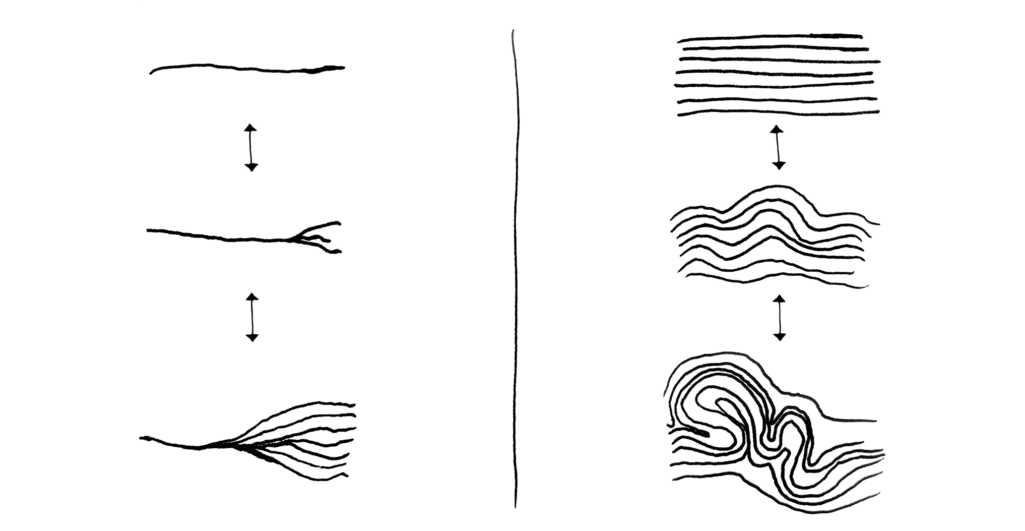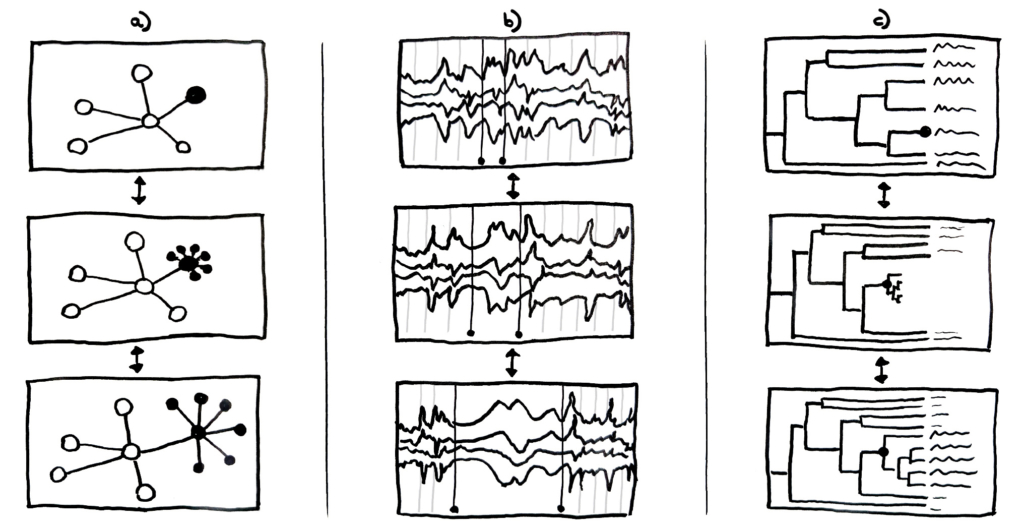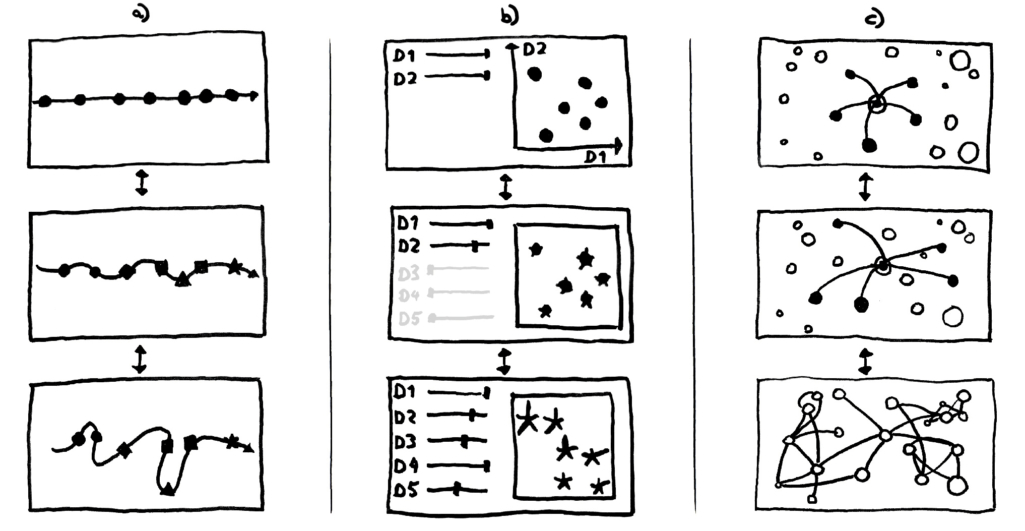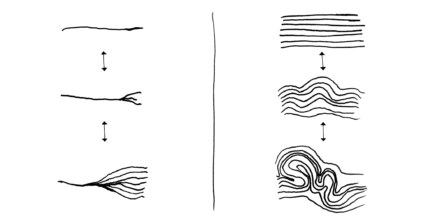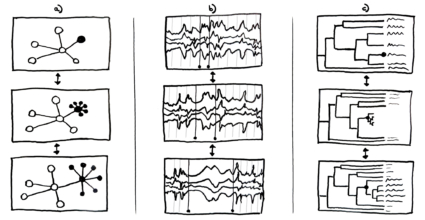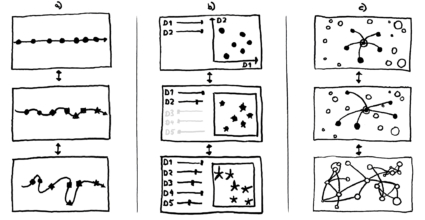The fold is a theory-driven research project that examines the role of interactivity in data visualization within the digital humanities. This work builds on the philosophy of Gilles Deleuze, who interpreted Leibniz’ monadology anew in his work “The Fold. Leibniz and the Baroque.” While Deleuze’s writing constituted a new paradigm of knowledge, difference and multiplicity, it can also serve as a metaphor for complex information processes. Extending this line of thought speculatively into the realm of digital information spaces, we transfer Deleuze’s notion of the fold to data visualization and derive qualities for humanistic visualization design and critique.
When visualizing humanistic data, it can be challenging to arrive at interactive visual representations that are meaningful and insightful, and enable a diverse set of user tasks from explorative engagement to focused analysis. Furthermore, visual information tends to be perceived as “true,” which has already sparked a debate over the role of the humanities in the design and interpretation of visualizations, understanding data as interpretive and calling for more ambiguity in their graphical expression. We propose the notion of the fold, advanced by French philosopher Gilles Deleuze, as a new way of interpreting and creating interactive visualizations of complex information spaces. The fold sheds light on the complexity of the underlying data and offers a new perspective on knowledge systems and their representation. While written in dense philosophical prose, the concept of the fold and the associated operations—explication, implication, and complication—can serve as an illuminating lens on visual interfaces and their interactive capabilities. More specifically, we believe that the fold offers an evocative design and research vocabulary for the digital humanities that considers visual encoding and interaction aspects in unison.
With this research we transfer Deleuze’s notion of the fold to data visualization and derive three concrete qualities for visualization design and critique in the humanities: coherence, elasticity, and infinity. In a next step, we characterize the manifestation of the fold’s operations and qualities in a range of exemplary visualizations with the help of interpretive illustrations and concrete examples from digital humanities projects. Lastly, we formulate a critical framework consisting of principles and questions for the design and interpretation of interactive visualizations and discuss open questions for future work at the intersection of data visualization design and humanistic inquiry. The fold has guided our visualization projects within the digital humanities for the last few years, enabling us to look more closely at the relationship between interactivity, visual encoding and the multiple states of a visualization and providing us with a new design and research vocabulary.
Publications
Associated Publications
—
DHQ: Digital Humanities Quarterly. 14:3,
2020
We propose the philosophical notion of the fold as an evocative vocabulary for the design and critique of interactive data visualizations. An expanding range of application areas, such as digital art history and literary studies, illustrates the potential of data visualization for research and education in the humanities. Coinciding with the increasing currency of data as evidence in the humanities, this research addresses a growing interest in data visualization for visual analysis and argumentation. For example, cultural collection visualizations promise a range of possibilities for visual and interactive representations of digital cultural heritage, used both for free exploration and focused research. Based on the concept of the fold, prominently advanced by Gilles Deleuze, this paper outlines a critical framework that draws attention towards the complexity of the underlying data. The fold offers a way to analyze and conceptualize visualizations through the lens of three integrated operations: explication, implication, and complication. It is an opportunity to think of interactive visualizations as portals into coherent, elastic, and ultimately infinite information spaces. Accordingly, it rejects the separation between interactivity and visual encoding and draws attention to the transitions between multiple states of a visualization. We identify design patterns of the fold in data visualizations, devise a framework for the critical interpretation of interactivity in data visualization, and demonstrate the implications for the digital humanities.
Expand
—
in: Konferenzband zur DHd 2020 Paderborn - Spielräume: Digital Humanities zwischen Modellierung und Interpretation,
2020
Wir schlagen den philosophischen Begriff der Falte als Denkraum für die Gestaltung und Interpretation interaktiver Datenvisualisierungen vor. Visualisierungen geisteswissenschaftlicher Sammlungen bieten spannende Möglichkeiten für interaktive Repräsentationen, welche die Sammlungen und ihre zugrundeliegenden Objekte zugänglich machen, sie aber ebenso kritisch beleuchten sollten. Dies führt nicht selten zu komplexen und teils widersprüchlichen Anforderungen an die entstehenden Visualisierungen. Das von Gilles Deleuze ausgearbeitete Konzept der Falte eröffnet einen Denkraum, der die Aufmerksamkeit nicht nur auf die Vielfalt visueller Repräsentation, sondern auch auf die vermeintliche Objektivität der zugrundeliegenden Daten lenkt. Darüber hinaus bietet die Falte eine Möglichkeit, Visualisierungen durch die Linse von drei integrierten Operationen zu analysieren und zu konzeptualisieren: Explikation, Implikation und Komplikation. Durch diese Linse betrachtet werden interaktive Visualisierungen zu Portalen, welche Zugang zu kohärenten, elastischen und letztlich unendlichen Informationsräumen anbieten können.
Expand
—
Computer Graphics Forum (Proc. EuroVis). 39(3),
2020
Through a design study, we develop an approach to data exploration that utilizes elastic visualizations designed to support varying degrees of detail and abstraction. Examining the notions of scalability and elasticity in interactive visualizations, we introduce a visualization of personal reading traces such as marginalia or markings inside the reference library of German realist author Theodor Fontane. To explore such a rich and extensive collection, meaningful visual forms of abstraction and detail are as important as the transitions between those states. Following a growing research interest in the role of fluid interactivity and animations between views, we are particularly interested in the potential of carefully designed transitions and consistent representations across scales. The resulting prototype addresses humanistic research questions about the interplay of distant and close reading with visualization research on continuous navigation along several granularity levels, using scrolling as one of the main interaction mechanisms. In addition to presenting the design process and resulting prototype, we present findings from a qualitative evaluation of the tool, which suggest that bridging between distant and close views can enhance exploration, but that transitions between views need to be crafted very carefully to facilitate comprehension.
Expand

